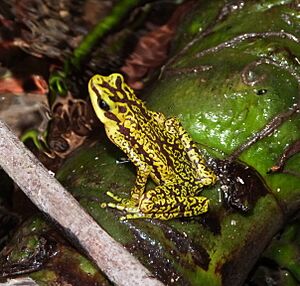Veragua stubfoot toad facts for kids
Quick facts for kids Veragua stubfoot toad |
|
|---|---|
 |
|
| Conservation status | |
| Scientific classification | |
| Synonyms | |
|
Phrynidium crucigerum Lichtenstein and Martens, 1856 |
The Atelopus cruciger, also known as the Veragua stubfoot toad or Rancho Grande harlequin frog, is a type of toad found only in Venezuela. For a long time, people thought this toad had disappeared completely. No one had seen it since 1986, even after searching very hard.
But then, in 2003, a small group of these toads was found! Later, a few more places where they live were discovered. Sadly, this toad is still in great danger. Its biggest threat is a serious frog disease called chytridiomycosis. In Venezuela, people sometimes call it sapito rayado, which means "striped little toad."
Contents
What Does It Look Like?
These toads are quite small. Adult males are about 2.8 to 3.5 centimeters long. Females are a bit bigger, measuring about 4 to 5 centimeters. Their bodies are thin. The front of their head, called the snout, looks pointy when you look down from above.
They don't have a visible eardrum, but they do have a raised ridge behind their eyes. They also have small, round bumps on their backs and sides. These bumps are most noticeable near their arms and in a line along their back. Their fingers have a little bit of webbing at the bottom, and their toes have even more webbing. Their back legs are quite long. When preserved, these toads look greenish-tan, with lighter colors on their bellies. Their backs have a pattern of dense brown squiggly lines and an X-shape behind their head.
What Do They Eat?
The Veragua stubfoot toad mainly eats ants. They also enjoy munching on other small insects they find.
Where Do They Live and How Are They Protected?
In the past, the Veragua stubfoot toad was very common. It lived all over the central Venezuelan Coastal Range. They could be found high up in the mountains, sometimes as high as 2,400 meters above sea level. Most often, they lived in forests near streams, cloud forests, or forests that lose their leaves. These areas were usually between 500 and 2,000 meters above sea level.
Atelopus cruciger usually stays close to streams and small rivers. They are active during the day. You can often spot them sitting on stones. They can also climb onto plants, sometimes as high as 1.5 meters off the ground. When it's time to have babies, they go to fast-flowing streams.
Sadly, the number of these toads has dropped a lot. Only a few groups of them are left today. These remaining groups are all found at lower elevations, between 220 and 500 meters, on the northern side of the Henri Pittier National Park.
The main reason for their decline is thought to be a fungal disease called chytridiomycosis. This disease is very dangerous for amphibians. Many toads that were studied in the past came from protected areas. Air pollution, like acid rain, might also be making things worse for them. This is because they live close to industrial areas like Valencia and Maracay.
In Culture
- This special frog is featured on the back of the Venezuelan Bs.S 5 banknote.


